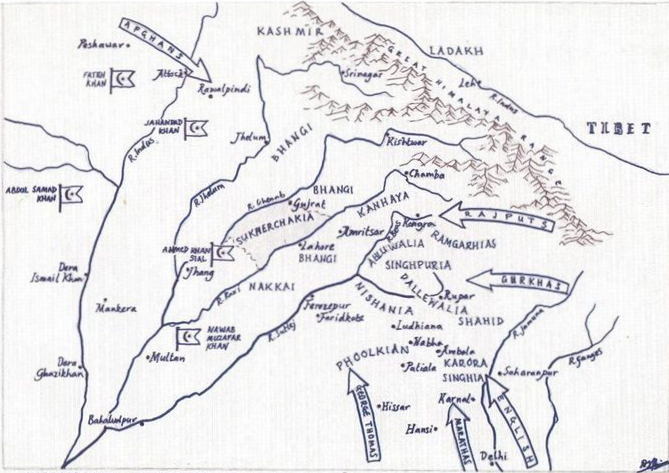Sikh Surnames & the Caste to which Sukerchakia’s belong….
Read More…
Sukerchakia’s
All families have a history, in case of certain Famous ones it is worth recording. The documenting of old families histories was not an easy task because in good old times it was largely an oral tradition in which generations of family bards (Marasis) recited family history on social and important occasions. This is the background to our history of Shakurchakia. The bravest of the brave in the history of Punjab. The Misl who ruled Punjab, produced an Alumni misldar who united the 12 Misl of Sikhs popularly known as the great warrior and Sher-e-Punjab Maharaja Ranjit Singh who later established an independent kingdom of Punjab.
Maharaja Ranjit Singh was a Shakurchakia. The family dynasty clan is Jat sikh Sandhu.
Origin-The Beginning
The ancestors of the Sukerchakias marched out of the mists of time moving eastwards into India and then northwards up the river valleys of the Punjab. Halted by the lower Himalayas this nomadic, martial tribe settled in a land inhabited by the indigenous Dasyus people with whom they lived in conflict for years before assimilation blurred tribal, social and cultural distinctions. They then experienced the Persian and Macedonian invasions followed by years of Mauryan peace. The Sukerchakia forefathers absorbed all these experiences and some more. They witnessed the Huns incursion into the Punjab, the advent of the Ghaznavid Turks, the rise and fall of the Khaljis, the repressions of the Tughluqs and the Lodhis and then three centuries of Mughal rule. How these tides of history influence the Sukerchakia ancestors, here after referred to as the Ancestors?how were the Ancestors shaped by centuries of alien influences, diverse customs and different creeds?
Sikh Surnames & the Caste to which they belong
Originally when Guru Gobind Singh Ji made the Khalsa, he banned castes and surname use, instead all Sikhs were either called Singh (Lion) or Kaur (Princess). Over the following years, in the times of Maharaja Ranjit Singh and the Sikh Missls eventually settled in those areas taking up farming. As they took up farming, they and the original Jat communities often merged, so it is often necessary to go back to these times to truly find the origin of the family.
During these time it was only the jat community that held a surname and most often the surname was the village to which they belonged. In this way it was the village to which they belonged. In this way it was largely used in official records, it later became a way of indentifying where a person came from.







